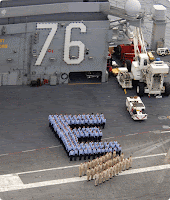On his CFFC Blog, Admiral Harvey posted the third in a series of messages about the "Practices of Successful Commands". His messages provide a great summary of some of those practices. You can go to his blog HERE.
For much greater detail and the full report on Command Excellence, you should really go HERE.
A short excerpt follows regarding the function of training in superior/excellent commands.
Training in superior commands links directly to combat readiness. Training for 'training's sake' is avoided. If a drill or exercise doesn't advance the combat readiness of the command, then it's changed around until it does.
Top commands don't question the value of training. The wardroom is key in coordinating training activities throughout the command. Each department commits itself to bringing its people up to speed. There is a give-and take in working with other departments to coordinate training activities. Training is targeted to get personnel closer to combat readiness. This drives the effort to keep training realistic and practical.
In outstanding commands all levels are involved in training and development. The wardroom coordinates the training, but the involvement of junior enlisted personnel with critical areas of expertise is crucial to training program success. Top wardrooms make their presence felt by continually monitoring programs to keep their commands combat ready.
Finally, superior commands are committed to the professional development and career planning of their people. Junior officers make sure their people are continuing to advance and qualify. Department heads take the lead in making sure division officers become qualified.

2 comments:
Captain (Special Duty Cryptology), I did indeed find the material you sent me useful. I remember the packages when they first came out and was very glad to receive them from you. And you're absolutely right, the key elements of command excellence are timeless.
Thanks very much for the feedback - I appreciate the time you took to write and help keep me in touch.
All the best and Merry Christmas, JCHjr
While not being one to underscore the value of training, there is also something to be said for 'not seeing the forest for the trees'. I am currently serving afloat as a SSES DIVO and will shortly be deploying. An interesting dilemma has hit many of the ships operating in our Strike Group when it comes to the required schools from the SURFORTRAMAN ... particularly in quota for schools. While the manual requires that 7 Sailors from each ship attend this or that particular school, we had been unable to meet the requirement based on our manning (having only 4 CTRs onboard for nearly all of the work up makes it very difficult to send 7 -- a point we have made time and again to no avail). Early in the cycle I was asking my fellow DIVO's how they made the requirement with similar manning issues and discovered they were filling gaps with anyone with the clearance for the school regardless of rating. So the two questions became:
1. Is it more important to satisfy the number requirement? Thereby masking the manning problems since I could send an IT or OS with the clearance to school, but the fact is they won't be in SSES using the training ... no more than if the CO or XO (who are also cleared) attended. Yes, sending an IT or OS will expose them to SSES, but they are not going to stand watches up there.
2. Or am I willing to stand up in the discussion and say I don't have the manning to make the requirement?
This was discussed with my CO and we chose to not send the IT's and OS's but found that leaders in the Strike Group find it more important to have green TFOM (Training Figures of Merit) markings than if we actually have enough people to perform the mission.
I agree gentlemen that training is important and improves and defines our combat readiness but if we mask the manning problems to just get our numbers up, we are not mission ready.
Post a Comment